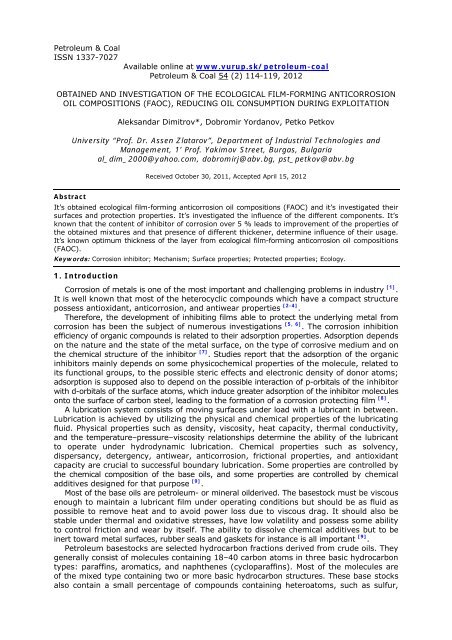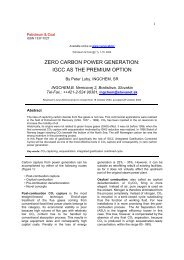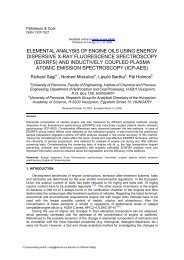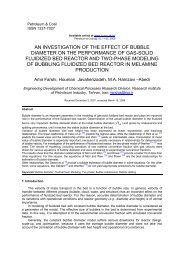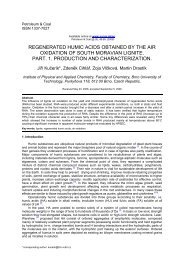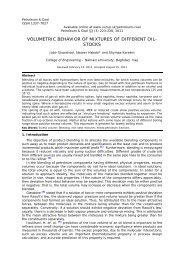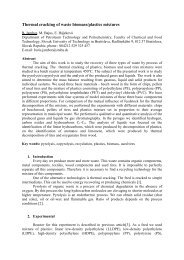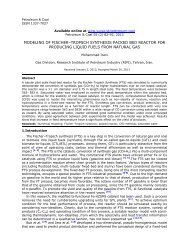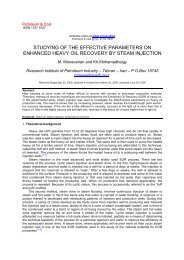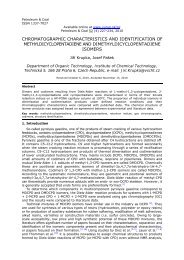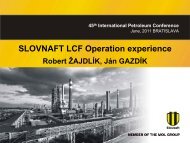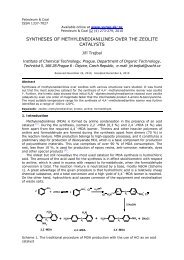Petroleum & Coal ISSN 1337-7027 Available online at www.vurup ...
Petroleum & Coal ISSN 1337-7027 Available online at www.vurup ...
Petroleum & Coal ISSN 1337-7027 Available online at www.vurup ...
You also want an ePaper? Increase the reach of your titles
YUMPU automatically turns print PDFs into web optimized ePapers that Google loves.
<strong>Petroleum</strong> & <strong>Coal</strong><strong>ISSN</strong> <strong>1337</strong>-<strong>7027</strong><strong>Available</strong> <strong>online</strong> <strong>at</strong> <strong>www</strong>.<strong>vurup</strong>.sk/petroleum-coal<strong>Petroleum</strong> & <strong>Coal</strong> 54 (2) 114-119, 2012OBTAINED AND INVESTIGATION OF THE ECOLOGICAL FILM-FORMING ANTICORROSIONOIL COMPOSITIONS (FAOC), REDUCING OIL CONSUMPTION DURING EXPLOITATIONAleksandar Dimitrov*, Dobromir Yordanov, Petko PetkovUniversity “Prof. Dr. Assen Zl<strong>at</strong>arov”, Department of Industrial Technologies andManagement, 1’ Prof. Yakimov Street, Burgas, Bulgariaal_dim_2000@yahoo.com, dobromirj@abv.bg, pst_petkov@abv.bgReceived October 30, 2011, Accepted April 15, 2012AbstractIt’s obtained ecological film-forming anticorrosion oil compositions (FAOC) and it’s investig<strong>at</strong>ed theirsurfaces and protection properties. It’s investig<strong>at</strong>ed the influence of the different components. It’sknown th<strong>at</strong> the content of inhibitor of corrosion over 5 % leads to improvement of the properties ofthe obtained mixtures and th<strong>at</strong> presence of different thickener, determine influence of their usage.It’s known optimum thickness of the layer from ecological film-forming anticorrosion oil compositions(FAOC).Keywords: Corrosion inhibitor; Mechanism; Surface properties; Protected properties; Ecology.1. IntroductionCorrosion of metals is one of the most important and challenging problems in industry [1] .It is well known th<strong>at</strong> most of the heterocyclic compounds which have a compact structurepossess antioxidant, anticorrosion, and antiwear properties [2-4] .Therefore, the development of inhibiting films able to protect the underlying metal fromcorrosion has been the subject of numerous investig<strong>at</strong>ions [5, 6] . The corrosion inhibitionefficiency of organic compounds is rel<strong>at</strong>ed to their adsorption properties. Adsorption dependson the n<strong>at</strong>ure and the st<strong>at</strong>e of the metal surface, on the type of corrosive medium and onthe chemical structure of the inhibitor [7] . Studies report th<strong>at</strong> the adsorption of the organicinhibitors mainly depends on some physicochemical properties of the molecule, rel<strong>at</strong>ed toits functional groups, to the possible steric effects and electronic density of donor <strong>at</strong>oms;adsorption is supposed also to depend on the possible interaction of p-orbitals of the inhibitorwith d-orbitals of the surface <strong>at</strong>oms, which induce gre<strong>at</strong>er adsorption of the inhibitor moleculesonto the surface of carbon steel, leading to the form<strong>at</strong>ion of a corrosion protecting film [8] .A lubric<strong>at</strong>ion system consists of moving surfaces under load with a lubricant in between.Lubric<strong>at</strong>ion is achieved by utilizing the physical and chemical properties of the lubric<strong>at</strong>ingfluid. Physical properties such as density, viscosity, he<strong>at</strong> capacity, thermal conductivity,and the temper<strong>at</strong>ure–pressure–viscosity rel<strong>at</strong>ionships determine the ability of the lubricantto oper<strong>at</strong>e under hydrodynamic lubric<strong>at</strong>ion. Chemical properties such as solvency,dispersancy, detergency, antiwear, anticorrosion, frictional properties, and antioxidantcapacity are crucial to successful boundary lubric<strong>at</strong>ion. Some properties are controlled bythe chemical composition of the base oils, and some properties are controlled by chemicaladditives designed for th<strong>at</strong> purpose [9] .Most of the base oils are petroleum- or mineral oilderived. The basestock must be viscousenough to maintain a lubricant film under oper<strong>at</strong>ing conditions but should be as fluid aspossible to remove he<strong>at</strong> and to avoid power loss due to viscous drag. It should also bestable under thermal and oxid<strong>at</strong>ive stresses, have low vol<strong>at</strong>ility and possess some abilityto control friction and wear by itself. The ability to dissolve chemical additives but to beinert toward metal surfaces, rubber seals and gaskets for instance is all important [9] .<strong>Petroleum</strong> basestocks are selected hydrocarbon fractions derived from crude oils. Theygenerally consist of molecules containing 18–40 carbon <strong>at</strong>oms in three basic hydrocarbontypes: paraffins, arom<strong>at</strong>ics, and naphthenes (cycloparaffins). Most of the molecules areof the mixed type containing two or more basic hydrocarbon structures. These base stocksalso contain a small percentage of compounds containing hetero<strong>at</strong>oms, such as sulfur,
A. Dimitrov, D. Yordanov, P. Petkov/<strong>Petroleum</strong> & <strong>Coal</strong> 54(2) 114-119, 2012 115nitrogen, or oxygen, substituted in the various hydrocarbon structures. Typical molecularstructures are illustr<strong>at</strong>ed in Fig. 1 [9] .Fig. 1. Molecular structures of base oil molecules.Ecological film-forming anticorrosion oil compositions (FAOC) are a new and compar<strong>at</strong>ivelylittle known class of conserv<strong>at</strong>ion m<strong>at</strong>erials with long-term potentials. FAOC are specialcompositions of different m<strong>at</strong>erials soluble in organic or inorganic solvents. After they arelaid on the protected metal surface, the solvent evapor<strong>at</strong>es and a solid, semi-solid or softco<strong>at</strong>ing with different thickness is formed. Thus, they can be used to protect various metalproducts from corrosion and corrosion - mechanical wear. FAOC consist of several typesof components: oil-soluble corrosion inhibitor; thickener; plasticizer; and a solvent [10-13] .2. ExperimentalDepending on the resources of our chemical industry, studies were focused on severalcomponents of film-forming anticorrosion oil compositional: CIC-2A (oil-soluble corrosioninhibitor); medium viscous paraffin (thickener); mineral oil (plasticizer); mineralturpentine (solvent).Mixtures were prepared by the following technology: the plasticizer was put in a 500ml glass in a quantity from 20 to 90% and, being continuously stirred; it was he<strong>at</strong>ed in aw<strong>at</strong>er b<strong>at</strong>h <strong>at</strong> 85÷90 o C. The thickener was added to it in amounts from 5 to 50 % and themixture was homogenized for 30÷45 minutes. The corresponding oil-soluble corrosioninhibitor was then added in amounts from 1 to 20%. The mixture was homogenized for30 minutes more. Then he<strong>at</strong>ing was stopped and <strong>at</strong> temper<strong>at</strong>ure 45 o C the necessary amountof the solvent was added, stirring going on as long as possible.In order to determine the protection effect of different film-forming anticorrosion oilcompositions depending on the thickness of the film, tests were carried out by the followingstandard methods:1. Bulgarian St<strong>at</strong>e Standard (BSS) 14353-77. Determining the protection ability againstaggressive gases and vapours in a chamber “Aggressive medium” (7 days and nights,33 o C, 100% humidity). Conditions are cre<strong>at</strong>ed periodically for the form<strong>at</strong>ion of a certainamount of sulphur oxide.2. BSS 14354-77. Determining the protection stability against salts in a “Salty fog”chamber (10 days and nights, 80 o C, 100% humidity) by periodically cre<strong>at</strong>ing conditionsfor the form<strong>at</strong>ion of fog from a 5% aqueous solution of sodium chloride.3. BSS 14355-77. Determining the protection stability against humid he<strong>at</strong>-clim<strong>at</strong>e regimein a “Humidity” chamber (7 hours per each 24 hours for a period of 12 days and nights)<strong>at</strong> changing temper<strong>at</strong>ure and moving most air in the chamber.4. BSS 14558-77. Determining the protection ability against condens<strong>at</strong>ion w<strong>at</strong>er in a“Condens<strong>at</strong>ion w<strong>at</strong>er” chamber (7 days and nights, 30 o C, 100% humidity).
3. Results and discussionA. Dimitrov, D. Yordanov, P. Petkov/<strong>Petroleum</strong> & <strong>Coal</strong> 54(2) 114-119, 2012 116The present study showed th<strong>at</strong> the amount of the various components mixed to obtainFAOC varies in the following ranges: oil-soluble corrosion inhibitor (CIC) - from 1 to 20%;thickener (T) - from 5 to 50%; plasticizer (P) - from 20 to 90%; solvent (S) - from 4 to20%. The recipe of the obtained FAOC is given in Table 1.Table 1 Recipe of the obtained FAOC.№ Oil-soluble corrosion inhibitor Thickener, Plasticizer, % Solvent, %(CIC), %%1. 1 5 90 42. 5 25 50 203. 10 30 40 204. 13 35 35 175. 20 50 20 10Mixtures with different consistency were obtained, which determines various fields oftheir applic<strong>at</strong>ion. These mixtures were subjected to a number of physicochemical tests tostudy their effect. The experimental results are shown in Table 2.Table 2 Test results for the FAOC obtained.№ PARAMETERS № of Table 1(Thickener: intermedi<strong>at</strong>eviscosity paraffin)1 4 51. PHYSICOCHEMICAL PROPERTIES1.1. The time needed for the film to dry completely, h 28,1 69,7 52,91.2. The time needed for the film to form, min 26,5 66,7 49,11.3. Colloidal stability, % 92,3 88,9 67,41.4. Flow temper<strong>at</strong>ure, o C 54,8 79,3 80,32. ELECTROCHEMICAL PROPERTIES2.1. Total resistance, R, Ω 2394 1751 15292.2. Change of the resistance on the film <strong>at</strong> 500 and 429 418 40520000 Hz, ΔR, Ω/cm 22.3. Rel<strong>at</strong>ive polariz<strong>at</strong>ion resistance, RPR, % 59 62 682.4. Rel<strong>at</strong>ive omic resistance, ROR, % 55 58 632.5. Change of the capacitive on the film <strong>at</strong> 500 and 5,1 6,7 7,420000 Hz, ΔC, μF/cm 22.6. Coefficient of inhibition 2,0 2,1 2,82.7. Permittivity 2,54 2,73 2,983. SURFACE-ACTIVE PROPERTIES3.1. W<strong>at</strong>er-replacing, mm: - d1 119 125 139- d2 123 129 139- d3 123 130 1393.2. Surface tension, mN/m 35 40 423.3. Limited wet angle, o : - FAOC 184 181 175- W<strong>at</strong>er on the FAOC 62 121 1704. PROTECTION PROPERTIES4.1. Conserv<strong>at</strong>ion of metal surfaces, beforehand wetwith 3% NaCl,% damaged surface: - Steel 3 48 13 8- Steel 10 42 11 7- Bronze 30 0 04.2. Protection properties in:A) Chamber “Humidity” (BSS 14355-77)- Steel 08 kp, number of cycle 4 6 9- Cooper, bal 3 2 1B) Chamber “Aggressive medium” (BSS 14353- 2,5124 1,9472 0,813577), mg “AM”C) Chamber “Condens<strong>at</strong>ion w<strong>at</strong>er” (BSS 14558- 2,3024 1,3517 0,608177), g/m 2D) Chamber “Salty fog” (BSS 14354-77), g/m 2 48,17 9,29 4,944.3. Velocity of protection, Z, % damaged surface 2 1 0
A. Dimitrov, D. Yordanov, P. Petkov/<strong>Petroleum</strong> & <strong>Coal</strong> 54(2) 114-119, 2012 117It was found th<strong>at</strong> the time needed for the film to form and dry completely, dependsexclusively on the amount of the solvent used to obtain FAOC. Colloidal stability mainlydepends on the plasticizer and the amount of the solvent in the film-forming anticorrosionoil compositions. Flow temper<strong>at</strong>ure depends in the first place on the amount and the typeof the thickener. Total resistance characterizes the isol<strong>at</strong>ion ability of the film with regardto the electrochemical reactions tailing place. It was found th<strong>at</strong> the values for this parameterdepend on the density of the film formed and the polarity of the consisting components.When the film is subjected to energy of altern<strong>at</strong>ing frequency, its stability changes.This process is studied tailing into account the value for ΔR. Increasing the amount ofthe polar components in the film-forming anticorrosion oil compositions, the values forRPR increase. On the same basis, the values for ROR show th<strong>at</strong> the density of the filmformed mostly depends on the amount of the thickener. W<strong>at</strong>er-replacing properties of FAOCdepend on the polar molecules present in them. This is also the case with the values fortheir surface tension. Increasing the amount of the inhibitor, the increase in the surfacetension of FAOC influences the size of the drops when FAOC are dispersed.At the same time, eventual w<strong>at</strong>er on the FAOC film will remain in the form of tiny dropsand will repel from the surface. This property is particularly important for conserv<strong>at</strong>ion ofmetal equipment and install<strong>at</strong>ions. The increased amount of inhibitors in the mixturesmakes it possible to avoid prepar<strong>at</strong>ion and drying or the conserved surfaces beforehand.The protection of products made of non-ferrous metals is stronger. By malting complextests it was found th<strong>at</strong> FAOC possess very good protection properties. The compositionscontaining low-viscosity paraffin can be used as conserv<strong>at</strong>ion oils. The use of petroleumresults in the production of FAOC which are suitable for conserv<strong>at</strong>ion of metal equipmentstored for a long time (up to 2 years) <strong>at</strong> compar<strong>at</strong>ively higher temper<strong>at</strong>ures (up to 40 o C).For longer conserv<strong>at</strong>ion (more than 2 years) <strong>at</strong> changing temper<strong>at</strong>ures, FAOC containingceresin as a thickener are more suitable. This type of thickener forms the most stable andthe densest film on the protected metal surfaces. If the amount of the inhibitor in thecompositions is less than 5 %, they should not be used to protect wet and most surfaces.Using an “Aggressive medium” chamber, conditions similar to a strongly aggressiveindustrial medium are cre<strong>at</strong>ed. The test aims <strong>at</strong> determining the stability of low-carbonsteel protected by conserv<strong>at</strong>ion oil under these conditions.The test made in a “Salty fog” chamber provides inform<strong>at</strong>ion about the ability of theconserv<strong>at</strong>ion m<strong>at</strong>erial to protect low-carbon steel in sea-we<strong>at</strong>her conditions.In the “Humidity” chamber, conditions for 100% humidity can also be cre<strong>at</strong>ed, the he<strong>at</strong>ingof w<strong>at</strong>er and the movement of the air in the chamber taking place in a cyclic recurrence.The test aims <strong>at</strong> determining the ability of the inhibited conserv<strong>at</strong>ion oils to protect lowcarbonsteel and electrolyte copper (99,9%).In the “Condens<strong>at</strong>ion w<strong>at</strong>er” chamber, the protected metal surface was subjected towashing and corrosion by condens<strong>at</strong>ion w<strong>at</strong>er drops running down because of the n<strong>at</strong>uralslope.The results from the corrosion tests carried out by the corresponding standard methodsare given in Table 3.It was found th<strong>at</strong> increasing the thickness of the film leads to an increase in itsprotection effect. These tests showed th<strong>at</strong> the optimum size of the layer of the ecologicalfilm-forming anticorrosion oil compositions (FAOC) should not exceed 100 μm. Thisdepends on the type of the thickener and the energy of the adsorption-chemisorptionsand adhesion-cohesion interactions in the film formed.The results obtained show th<strong>at</strong> the ecological film-forming anticorrosion oilcompositions (FAOC) under study can be used to solve some very old problemsconnected with technical equipment kept under conditions of temporary, seasonal or longoutage. This problem is particularly important for motor transport which is subjected tostrong electrochemical corrosion, especially in winter because of the antifreezeoper<strong>at</strong>ions on the road network. The properties of ecological film-forming anticorrosionoil compositions (FAOC) with different consistency make it possible to take measures forprotecting not only the outer surfaces of vehicles but also to conserve inner surfaces,which are difficult to reach, by injection through specially made openings.
A. Dimitrov, D. Yordanov, P. Petkov/<strong>Petroleum</strong> & <strong>Coal</strong> 54(2) 114-119, 2012 118Table 3 Effect of the film thickness on the protection properties of FAOC.N o ofcompositionon the FAOC<strong>at</strong> Table 1.Thickener(Intermedi<strong>at</strong>eviscosityparaffin)Thickness of thefilm14355-77Steel 08 kp CooperCORROSION TESTS (BSS)14355-77 14558-77 14354-77μmnumber ofcyclebal mg “AM“ g/m 2 g/m 22 10-20 4 3 2,1080 1,6837 13,193 10-20 4 3 2,0974 1,6617 12,945 10-20 5 2 2,0351 1,5984 12,702 20-35 5 2 2,0227 1,5513 12,633 20-35 5 2 2,0199 1,5247 12,575 20-35 5 2 2,0091 1,5049 12,502 35-50 5 2 2,0017 1,4813 12,463 35-50 5 2 1,9913 1,4784 12,035 35-50 6 1 1,7991 1,4291 11,532 50-100 7 1 1,7845 1,2056 11,753 50-100 7 1 1,7729 0,1971 11,415 50-100 8 0 1,6120 1,1252 10,592 100-150 8 0 1,1738 0,9156 9,773 100-150 8 0 1,1057 0,9037 9,135 100-150 9 0 0,9981 0,8794 8,582 150-200 10 0 0,1738 0,9156 9,773 150-200 11 0 1,1057 0,9037 9,135 150-200 12 0 0,9981 0,8794 8,582 200-300 13 0 0,8974 0,8413 8,353 200-300 13 0 0,8324 0,8324 8,015 200-300 14 0 0,8711 0,8117 7,492 300-400 14 0 0,8750 0,8074 7,173 300-400 14 0 0,8694 0,8003 7,055 300-400 15 0 0,8603 0,7974 6,902 400-500 14 0 0,8538 0,7941 6,983 400-500 15 0 0,8494 0,7886 6,115 400-500 16 0 0,8403 0,7421 5,944. ConclusionEcological film-forming anticorrosion oil compositions (FAOC) were studied in order todetermine the influence of the consisting components on their protection effect.An increase in the amount of the inhibitor over 5 % results in improving physicochemical,protection and surface-active properties and makes it possible to avoid preliminaryprepar<strong>at</strong>ion and drying of the protected surfaces.A good protection effect is achieved when the layer of the ecological film-forminganticorrosion oil compositions (FAOC) is not more than 100 μm thick.The presence of different thickeners leads to a change in the field of applic<strong>at</strong>ion of theecological film-forming anticorrosion oil compositions (FAOC), the we<strong>at</strong>her conditions andthe time of usage.
ReferencesA. Dimitrov, D. Yordanov, P. Petkov/<strong>Petroleum</strong> & <strong>Coal</strong> 54(2) 114-119, 2012 119[1] Aiad, I.A., Hafiz, A.A., El-Awady, M.Y., Habib, A.O.: J. Surfact Deterg., 2010, 13,247-254.[2] Bh<strong>at</strong>lacharya, A., Singh, T., Verma, V., Nakagama, K.: Wear, 1990, 136, 345-352.[3] Davis, R.H., Famg, L.O., Horodysky, A.G.: US P<strong>at</strong>ent 4,908,144.[4] Karol, T.J., Eur. P<strong>at</strong>. Appl., EP 0,209,730.[5] Scendo, M., Hepel, M.: J. Electroanal. Chem., 2008, 613, 35-50.[6] Otmacic, H., Stupnisek-Lisak, E.: Electrochim. Acta, 2003, 48, 985-991.[7] Bentiss, F., Lagrenee, M., Traisnel, M., Hornez, J.C.: Corrosion Sci., 1999, 41,789-803.[8] Bentiss F., Traisnel, M., Lagrenee, M.: J. Appl. Electrochem., 2001, 31, 41-48.[9] Hsu, S.M.: Tribology Intern<strong>at</strong>ional, 2004, 37, 553-559.[10] Shechter, U.N., Zubareva, M.A., Bogdanov, I.S.: Chimia i technologia topliv imasel, 1989, 3, 43. (in Russian)[11] Shechter, U.N., Zaskalko, P.P.: Chimia i technologia topliv i masel, 1984, 2, 55.(in Russian)[12] Engmin A.B., Konslin, A.V., Ivanova, T.N.: Chimia i technologia topliv i masel,1984, 3, 74. (in Russian).[13] Estivao, L., Rascimento, R.: Corrosion Science, 2001, 43, 1133-1153.


